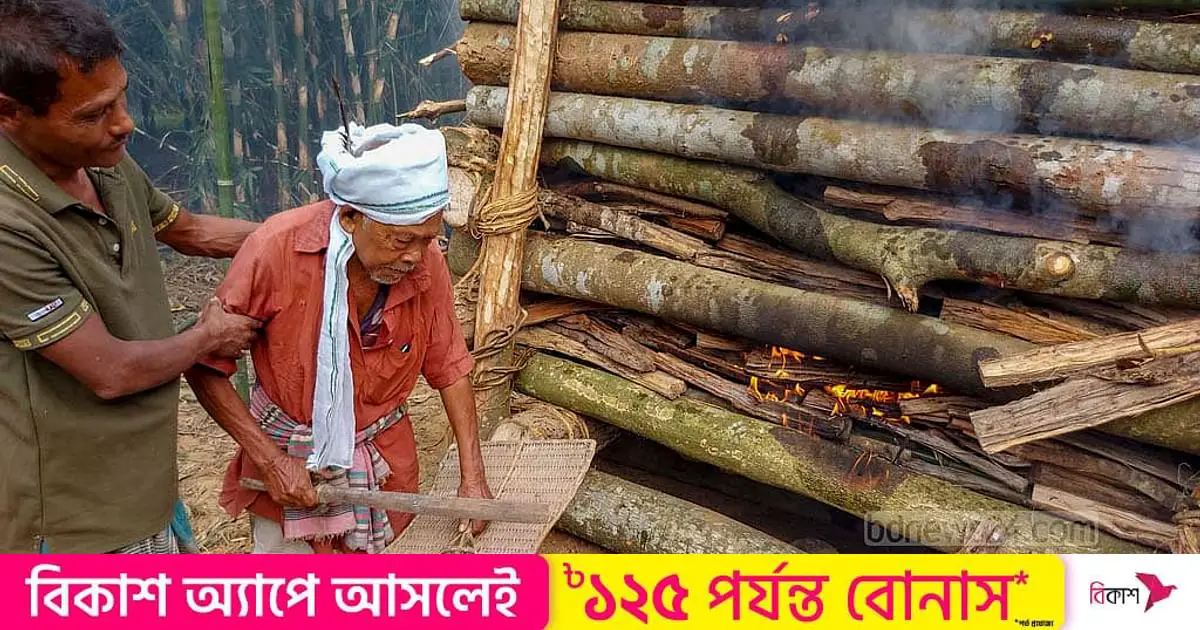Both Wari and Sheetal were married according to Sangsarek customs. They call it dobuk daka or dosia marriage. The priest who conducts such marriages is called Kamal or Khamal in the language of Mandi.
Vari said: “Marriage is an important point in life between birth and death and the whole process is bound by faith. That’s why there is a need to institutionalize the Sangsarek religion as well. The practice of the revived faith can be sustained only if this generation of Garos can be educated in the lotus form. The lotuses alive today are over 70 years old. After he dies, we will not be able to find practitioners.”
Researcher Powell, however, sees a “new awakening” of sangsarek among the younger generation of Garos.
“We have seen a decline in the number of Sanskarek followers in the last two decades. Also, there is a new awakening in the younger generation of Mandi and many are identifying themselves as Sangsarek.”
“Sangsarek philosophy is not just human-centred, it is an interconnected worship of all earthly life. The same can be said about Sari, Sarna and Niyam Chhonang. I just want everyone to recognize themselves. be able to be who they want to be. I urge recognition of people’s right to self-identification.”
acceptance of religion
Sari and Sarna followers outnumber Sangsarek practitioners and are generally known as Sanatan Santhal people.
Manik Sarin, secretary for information and research at the Jatiya Adivasi Parishad, said: “We have been demanding recognition of Sari and Sarna as Sari-Sarna religion for a long time. The followers of the religion are forced to identify themselves as Sanatan or Hindu.”
All people of the Kheroyal, or Mundari language family, are part of religious minorities, such as the Santhals, Mundas, Kols, Mahalis, Kurmis, Bhils, Hond Bhumijs. Of them, about half of the Santhal community converted to Christianity but the rate is lower among others.
The Santhal numbers are closer to the Bengali population in the north of the country. They identify themselves as followers of Sari Dharam, while others say they are part of Sarna. The Santhal people of West Bengal, Bihar and Jharkhand also identify themselves as Sarna. Born in a Santhal family, Manik said that these two are ancient nature-worshipping religions of the Indian subcontinent.
Manik married in the Sar Sagune Biha tradition of the Kheroyal people. But the religion has no documentary recognition, and thus lacks methods of official registration.
Tarun Khokan Switen Murmu, who is in Australia for higher studies, said, “The mode of marriage will be accepted only if there is a religious identity.”
“We are unable to give our ethnic identity. We were forced to speak Bangla as our mother tongue at the beginning of our education in childhood. Santhal religion is not mentioned in the census. We have to call Bangla our language and the constitution refers to us as minorities.
He said that the official census is quite different from the Bangladesh Tribal Forum and the Ethnic Tribal Council.
According to this year’s census, there are 129,048 Santal people living in Bangladesh but in 1991 the figure was above 200,000.
“There can be no reason for the population decline to last more than a decade. But our population is never properly represented in the census. Tribal Council figures say that there are more than 500,000 Santhals living in the country and at least half of them practice sari-sarna, which is not even mentioned in the census.”
Both Khokan and Manik believe that the total number of Sari-Sarna followers from Santhals and other groups is more than 300,000.
Endangered religion of the Khasis
In the Khasi traditional religion Niyam Khasi, also known as Jaintia, the principal deity is U Blei Nongthaw, who is believed to be formless and the supreme creator of the entire universe.
According to the latest census there are 12,421 ‘Khasias’ or Khasis in Bangladesh. However, according to Subimal Longdkiri, a leader of the ethnic group, the actual number is more than double.
Subimal, a lawyer by profession, lives in Madhabkunda village of Borolekha upazila in Maulvibazar, where almost everyone except his family has converted to other religions.
Almost all Khasis come from the Greater Sylhet district. Subimal believes that thousands of Khasis still practice their traditional religion in the country.
“There are one or two families in every Khasi village who have not yet converted,” he said. “However, Jaintiapur in Sylhet has the largest number of ‘Chhonang’ people.”
Sanchita Yangyung, a teacher at Vitri Khel Government Primary School in Jaintiapur, said everyone in her Khasi neighborhood is ‘Niyam Chhonang’ or Niyam Khasi. Their number is around 300.
‘Hakatai’ is the biggest religious festival of Niam Khasi. Adherents celebrate it on the seventh day of the fortnight in the Hindu lunar calendar in the month of Magha, the tenth month in the Bengali calendar, in memory of ancestors, for the peace of their souls and for their well-being.
On that day, fruits, cakes and other food items are offered to the gods and the dead. Presently, the festival is not held anywhere except Jaintiapur.
Mros religions, both old and new, are not in the census.
Among the various ethnic minority communities of the Chattogram Hill Tracts, the Maros are the fourth most populous after the Chakma, Marma and Tripura tribes. According to the latest census report, their number is around 52,455.
In 1984 a young man named Manle Mro founded the ‘Krama’ faith which is currently the most followed religion among the Mro. Converted Christians are second, while the rest are Buddhists.
Changyung Murung, general secretary of the Bangladesh Indigenous Students Action Forum, said many followers of the old religion of the MRO consider themselves Buddhists. However, it is not like traditional Buddhism.
The antelope call their old religion ‘Shungnam Ri’. In the Mro language ‘Shungnam’ means God and ‘Ri’ means ritual. However, those who still practice their old religion feel hesitant to “introduce themselves even among other Mros,” said Changyung, a student at Dhaka University’s Department of Management Information Systems.
Followers of Shungnam Ri worship in canals, forests and mountains to appease the deities of nature. His religion can also be called naturalistic religion.
However, the Changyoung family follows the Krama Dharma.
The MRO people believe that the cow had eaten their letters. They celebrate a festival in which a cow is sacrificed to commemorate the occasion.
“Manle came and claimed that he had brought the alphabet from Kramadi. Not only this, he also brought a scripture. That’s why cow slaughter should be stopped.
However, highlighting that neither the followers of Shungnam Ri nor the Krama are noted according to their religion in the census, Changyung said, “I studied Christianity. Many people learn about Buddhism.” receive academic education as well. But the Krama want to study their religion in school.”
what does the constitution say
The followers of these religions who are outside the mainstream in Bangladesh want the right to adopt, practice, propagate and identify themselves according to their religion. Everyone has the right to practice their religion in the state constitution.
Supreme Court lawyer Parvez Hashem referred to Article 41 of the Constitution which states that “every citizen has the right to profess, practice or propagate any religion”.





